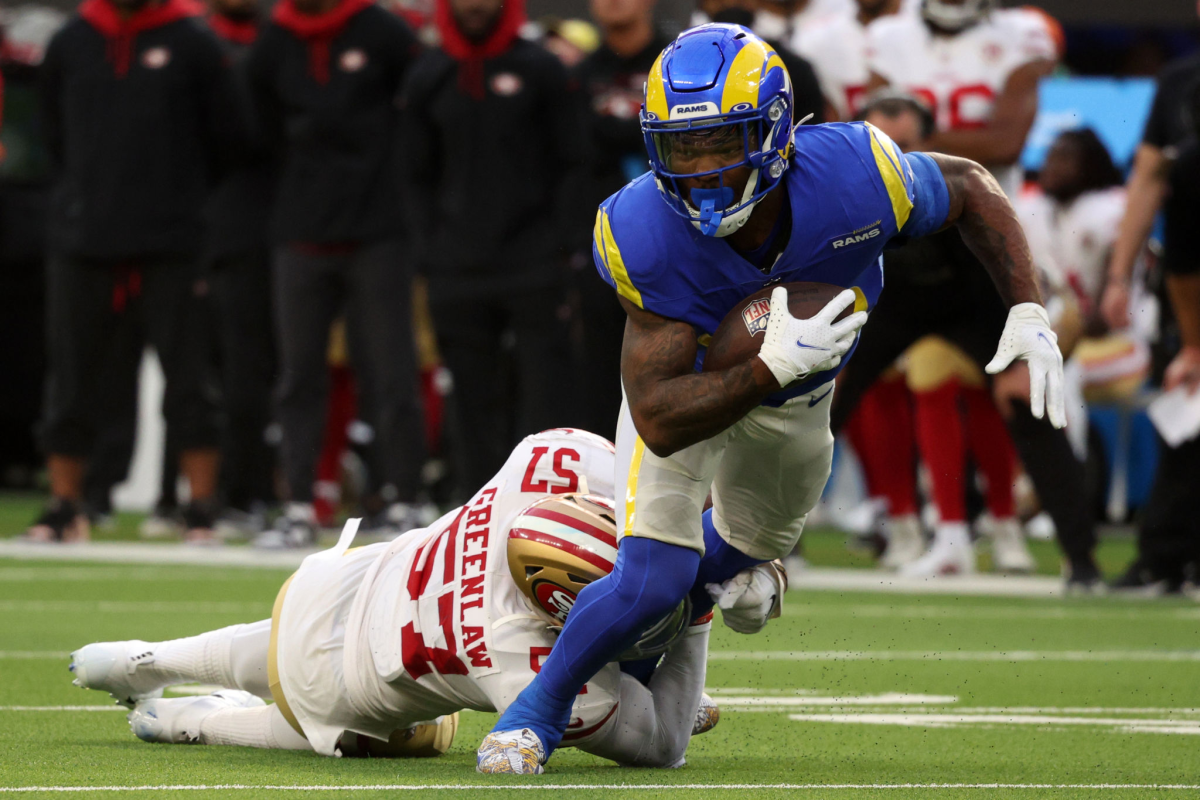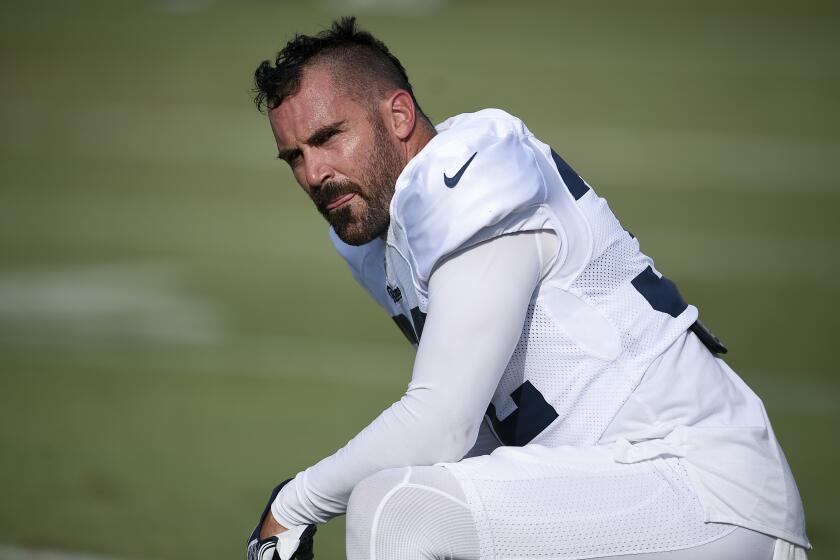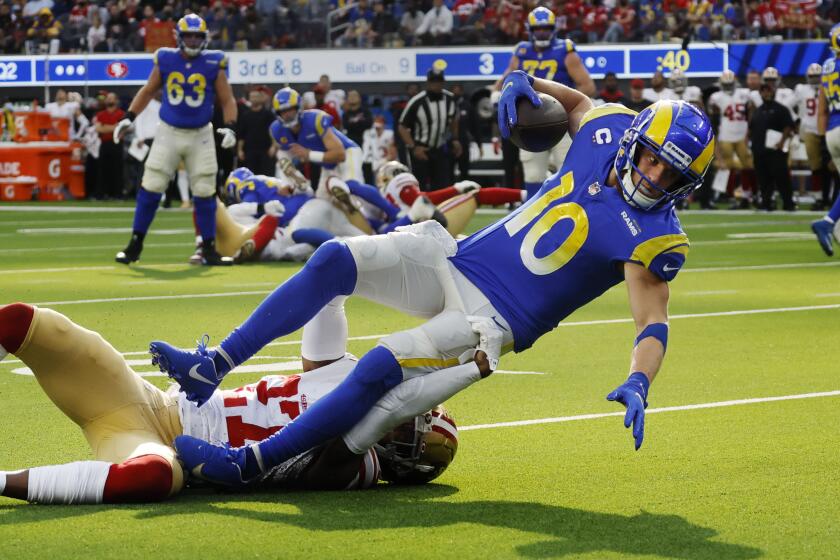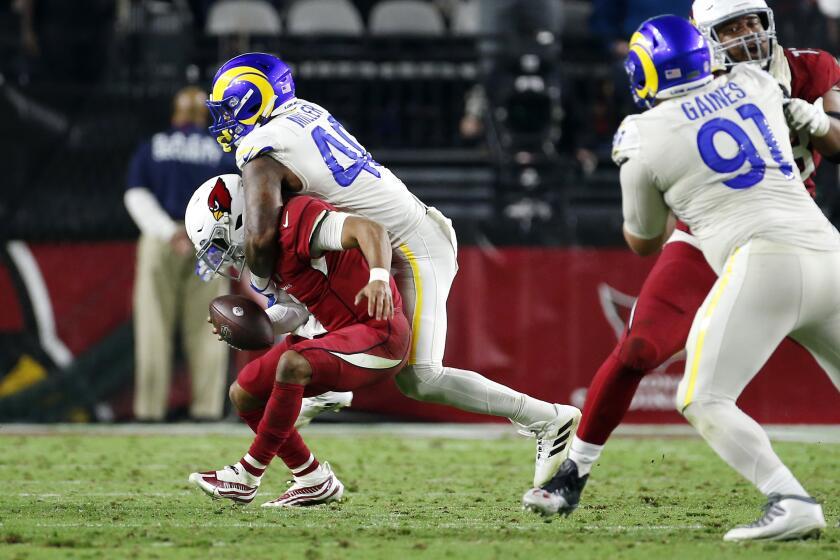How is Cam Akers even playing? The major factors that sped up his Achilles recovery

- Share via
The Hail Mary was caught in the end zone. The hook and ladder resulted in a touchdown.
Instead of the standard nine months to a year, Akers returned from a torn right Achilles in less than six months, in time for the Rams’ postseason opener on Monday against the Arizona Cardinals at SoFi Stadium.
The same Los Angeles-based surgeon who extended Tom Brady’s career might have salvaged the Rams’ season. Neal ElAttrache of the Kerlan-Jobe Orthopedic Clinic improved a procedure he once used to repair Kobe Bryant’s tendon to ensure the dramatic return of the pass-catching running back.
As miraculous as this feels, ElAttrache insisted there was nothing supernatural about Akers’ comeback.
With Jordan Fuller out with an ankle injury, the Rams coaxed safety Eric Weddle out of retirement to bolster the defensive backfield in the playoffs.
“I don’t want to come off as this mad scientist magician,” ElAttrache said with a self-effacing chuckle.
Rather, ElAttrache said, Akers’ recovery was the product of a confluence of factors — the evolution of surgery, advancements in rehabilitation and the patient’s determination.
“When you talk about those three things coming together, you get a special outcome,” echoed Reggie Scott, the Rams’ vice president of sports medicine and performance.
Injured in mid-July before the start of training camp, Akers was cleared to practice on Dec. 23. He played in the Rams’ regular-season finale Sunday as a final tuneup for the playoffs, touching the ball eight times.
How quickly he returned, according to ElAttrache and Scott, could be directly linked to how quickly he underwent surgery and how quickly he started rehabilitating after the operation.
“For every day that you have decreased stimulation of the muscle, it takes two days to come back where you were,” ElAttrache said.
In other words, decreasing the downtime at the start of the recovery process also decreases the time required to regain strength at the end.
Akers was injured while working out in Thousand Oaks, near the Rams’ practice facility, according to Scott. The relative proximity to ElAttrache was important. So was Akers’ decisiveness.

“In less than 24 hours, he comes and looks at me and says, ‘Hey, Reg, let’s go,’” Scott said.
Akers was less than a week removed from tearing his Achilles when ElAttrache operated on him, Scott said.
The process was also accelerated by ElAttrache’s surgical expertise.
ElAttrache likened repairing a torn tendon to stitching together the ends of two mops.
By the time he repaired Bryant’s Achilles in April 2013, ElAttrache was incorporating a technique he learned from Scottish surgeon Gordon Mackay, who added an extra suture designed to absorb tension.
“So all of the tension is not at the repair line,” ElAttrache said.
ElAttrache was also using a “looping” technique when stitching together the tendon, with the pattern also designed to absorb strain.
Bryant was back to playing games less than eight months after his surgery, which at the time was considered fast.
The Rams’ first playoff task is to beat the slumping Arizona Cardinals, and that will require stopping the run.
Since then, ElAttrache has increased his use of a braided suture that is flatter, wider and provides greater security. The medical community also has a better idea of how the body responds to these surgical techniques and devices, allowing trainers and physical therapists to better map out the recovery process.
Two days after ElAttrache operated on him, Akers was able to start physical therapy under the watch of Rams rehabilitation director Byron Cunningham.
“We started working above the joint,” Scott said. “We started working his quad, we started working his hamstring.
“We use a whole bunch of different neuromuscular stimulations.”
Scott’s team also used blood flow restriction therapy, which was developed to treat wounded veterans.
Soon, an anti-gravity treadmill was introduced to Akers’ program.
About a month after his operation, Akers was walking in a boot. At the 10- to 12-week mark, he was jogging. At the 12- to 14-week mark, he was sprinting.
Akers, who hasn’t spoken to reporters since he was hurt, had a mindset well-suited for the task.
“Rehab is hard,” Scott said. “It’s just a one-day-at-a-time, one-step approach.”
Akers’ progress was guided by metrics provided by sports science director Tyler Williams, who, for example, used plates to test the force with which Akers could decelerate and push off with each leg. (By the time he returned, Akers’ surgically repaired right leg could generate more force than his left, according to ElAttrache.)
Joey Blake oversaw Akers’ nutrition.
When Akers was removed from the non-football injury list Dec. 23, the medical staff’s main concern was rebuilding his psyche.
First look: History lesson, current events and matchup prediction for Cardinals at Rams NFC wild-card playoff game next Monday night.
ElAttrache said he knew Akers was ready when he received a call from Scott before the Rams’ Week 17 game in Baltimore.
“Guess who’s not happy they’re not playing?” Scott asked.
“That’s music to my ears,” ElAttrache told him.
In his return, Akers’ impact in the Rams’ 27-24 overtime loss to the San Francisco 49ers on Sunday was modest. He rushed five times for three yards and caught three passes for three more.
What touched Scott was how players on both teams congratulated Akers for his comeback, how they viewed what he did as miraculous.
“The coolest thing about it is that you got a front row seat to all the hard work that went behind that,” Scott said. “So when you see it out there, you have a really good perspective on how hard this was to do. And it just shows you the kind of special person Cam is and what kind of special group that we have around.”
More to Read
Go beyond the scoreboard
Get the latest on L.A.'s teams in the daily Sports Report newsletter.
You may occasionally receive promotional content from the Los Angeles Times.










